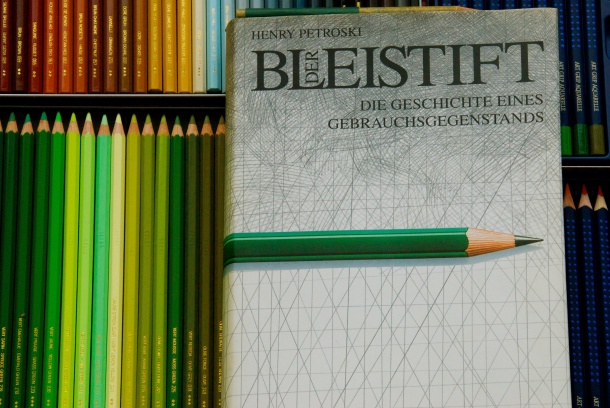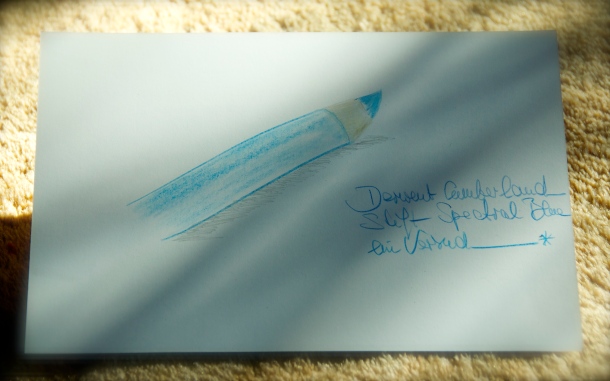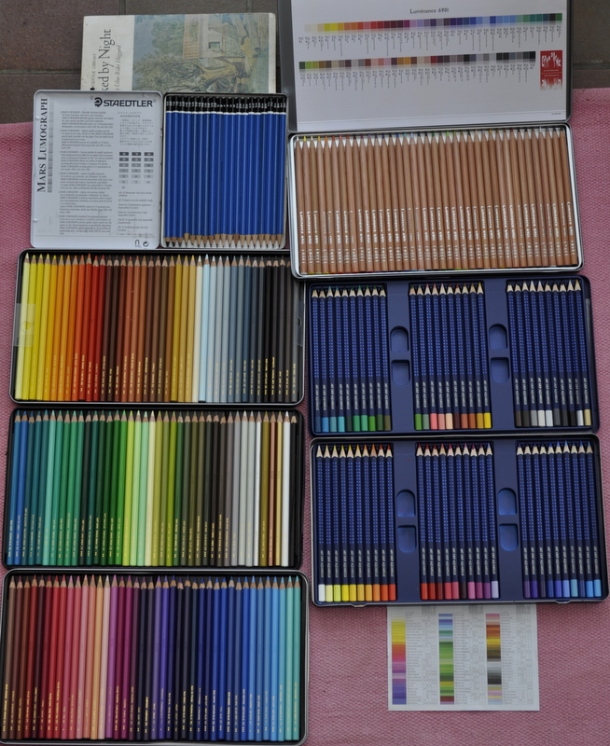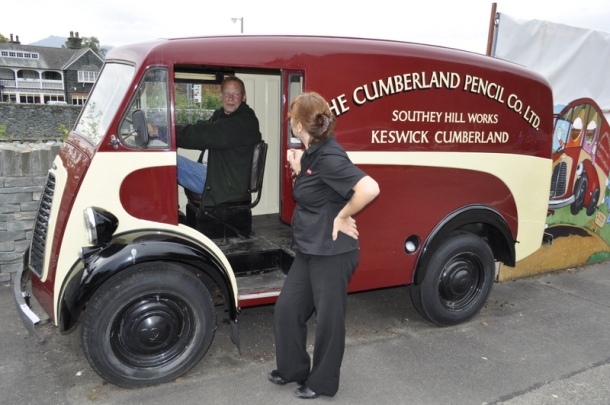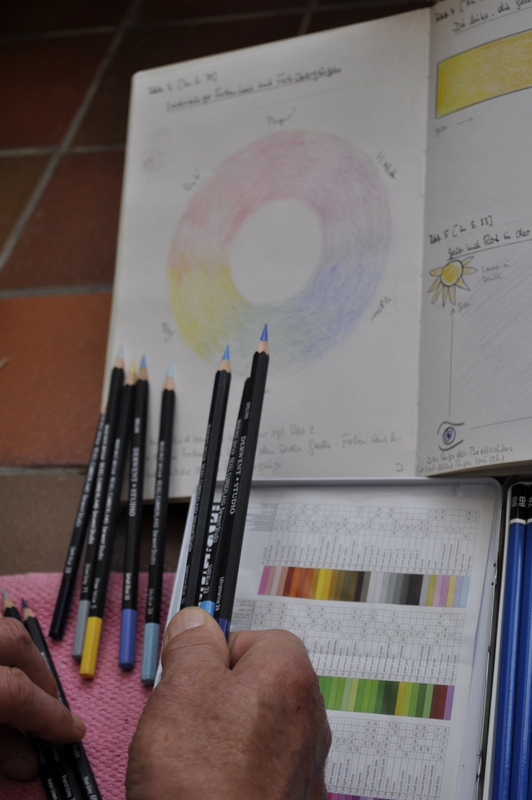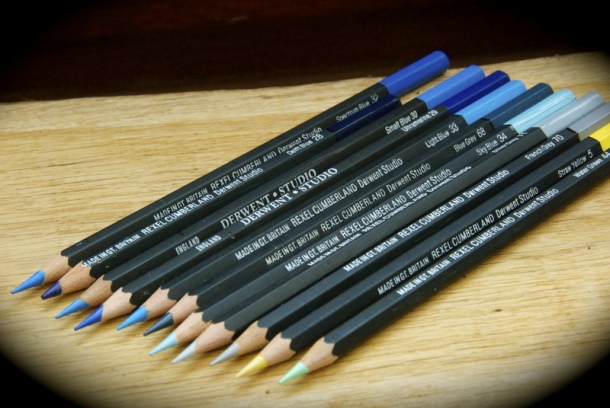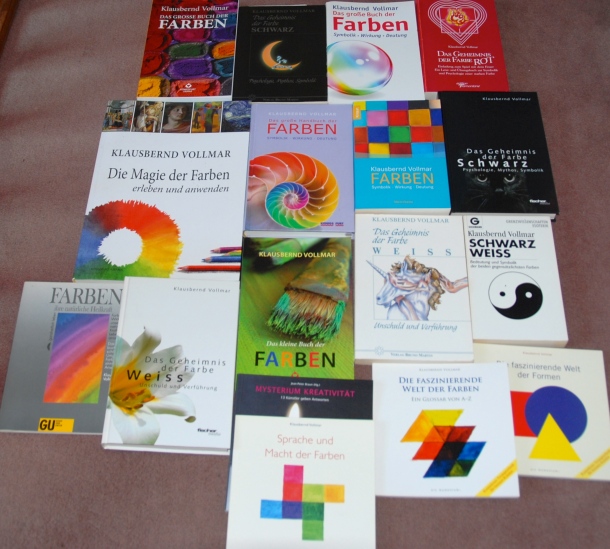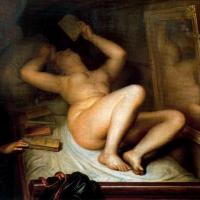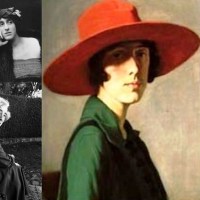Ich bin ein Bleistift
I am a pencil
Henri de Toulouse-Lautrec
.
Wisst ihr was? Der unscheinbare Bleistift, der in unserem Haus überall herumliegt, hat in enormen Maße zu unserer Kulturgeschichte beigetragen. Da wundert ihr euch, aber stellt euch vor, bevor es es den Bleistift gab, konnte man sich nicht flugs seine genialen Gedanken skizzieren oder schriftlich schnell etwas berechnen – zumindest nicht so bequem wie mit dem Bleistift und etwas ausradieren zur Überarbeitung konnte man auch nicht (damals radierte man mit frischem Weißbrot). Wir lasen, dass gemäß einer Umfrage zumindest noch vor zehn Jahren der Bleistift das beliebteste Arbeitsmittel von Designern, Ingenieuren und Architekten war und dass weltweit noch 14 Millionen Bleistifte jährlich hergestellt werden.
A pencil and a rubber are of more use to thought than a battalion of assistants
Theodor W. Adorno
Freilich gab`s schon vorher Stifte aus Silber und Blei, das übrigens im heutigen Bleistift nicht mehr zu finden ist. Diese Metallgriffel schrieben hauchdünn und wie leicht beschäftigte man die Schreibfläche – meist Papyrus – mit ihnen. Außerdem gab`s die leicht verwischbare Kohle, die schwer zu spitzen war.
Admittedly there have already been pencils of silver and lead before. But these metal pens wrote very thin and they easily scratched the page – mostly papyrus – too much. There was also charcoal but its lines easily smudged and became blurred and charcoal it was hard to sharpen.
Wir haben noch in der Feenschule mit dem Bleistift gelernt zu schreiben und zuvor Strichmännchen, Sonnen und Wolken emsig gezeichnet, auf die wir mächtig stolz waren. Unser Traum war ein großer Kasten „richtiger“ Buntstifte, speziell nachdem Masterchen uns die Geschichte des legendären Koh-I-Nor-Stiftes erzählt hatte.
Pencils mean freedom whereas the computer dictates how to use it
Siri
Der Koh-I-Noor, „der Bleistift mit einem Gefühl wie Seide, so leicht wie ein Schmetterling“, der 1893 auf der Columbia Exhibition vorgestellt wurde, war goldgelb lackiert. Ich glaube er kam aus Bloomsberry/New Jersey, wo er mit 14 Schichten goldgelben Lacks versehen wurde; die Enden wurden mit Goldbronze überzogen. Der Schriftzug bestand aus Blattgold. Die gelbe Lackierung der Bleistifte wurde gewählt, da diese Farbe auf die orientalische Herkunft des Graphits (Sri Lanka, Indien) hindeuten sollte. Andere Marken kopierten diese Kennzeichnung. Ursprünglich wurden auch die Stifte in Keswick gelb lackiert, um schadhaftes Holz, das für billige Bleistifte genutzt wurde, zu übertünchen.
The Koh-I-Noor, „the pencil with a feeling like silk, as light as a butterfly“, presented at the Columbia Exhibition in 1893, was painted yellow gold. It was produced in Bloomsberry / New Jersey, equipped with 14 layers of golden yellow paint and the ends were leaf gilded. The writing consisted of gold leaf (16 carat). The yellow paint of these pencils was chosen because this color should indicate the oriental origin of the graphite (Sri Lanka and India). Other brands copied the yellow colouring for their pencils later. Originally most of the pencils from Keswick were painted yellow, too – but to cover up defective wood that was used for cheap pencils.
Der moderne Bleistift kam jedoch nicht aus Amerika sondern aus dem nördlichen Lake District, aus Keswick, wo die Bleistiftfirma Derwent Cumberland (Derwent ist der Fluss hier, Cumberland die Grafschaft) residierte. Hier hat man zuerst das damals noch weitgehend unbekannte Graphit (unter einer umgefallenen Eiche) gefunden, das das Blei des Bleistifts ersetzen sollte. Es wurde zunächst als Englisches Antinom bezeichnet. Der erste dieser modernen Stifte wurde in Keswick wahrscheinlich um 1550 produziert. Königin Elizabeth holte deutsche Fachleute in den Lake District, um das Graphit speziell in den Borrowdale Gruben abzubauen. Sie machten Graphit auch in Deutschland bekannt. Im 17. Jh. kam der große Durchbruch, als ein Schreiner aus Keswick auf die Idee kam, die Graphitminen in Holz zu fassen. Graphit aus Cumberland wurde plötzlich derart wertvoll, dass King Georg II. 1752 ein Gesetz zur geregelten Ausbeutung der Graphitlager in den Lakes verabschiedete, außerdem durfte das gefragte Graphit aus Keswick nur in Form englischer Bleistifte exportiert werden. Mitte des 19. Jh. waren die Graphitvorkommen im nördlichen Lake District erschöpft und man importierte Graphit aus aus Asien und Flusszeder und brasilianische Pinie zur Bleistiftherstellung, die bis heute noch um Keswick zu finden ist.
The modern pencil doesn`t originate in America but in the northern Lake District in the town of Keswick, where the Derwent Cumberland Pencil Company (Derwent is the river there, Cumberland the County ) resided. Here the still largely unknown graphite was found for the first time under a fallen oak, the graphite that should replace the lead of the pencil. It was referred to as English Antimon. The first of the graphite pencil was probably produced in Keswick around 1550. Queen Elizabeth I had invited German specialists to the Lake District to mine graphite in the Borrowdale mines. These miners made graphite known in Germany which should become the biggest competitor to England on the pencil marked.
In the 17th c. came the big breakthrough as a carpenter from Keswick got the idea to cover the graphite in wood. Graphite from Keswick suddenly became so valuable that King George II signed a law (1752) for the controlled exploitation of the graphite. He also decreeted the graphite from Keswick could be exported only in form of English pencils.
The graphite deposits in the northern Lake District were exhausted middle of the 19th c. From now on graphite was imported from Asia as well as cedar wood for the pencil production which is still to be found at the northern Lake District.
Die Graphitvorkommen von Keswick ließen jahrzehnte lang eine beliebte Heimindustrie in den Lakes entstehen und ernährten die Bauern dieses Gebiet eine lange Zeit gut.
The graphite deposits of Keswick created a popular cottage industry in the northern Lakes for many centuries. It helped the sheep farmers to an additional income.
A pencil and a dream can take you everywhere
old saying
Wir Buchfeen waren enttäuscht von Keswick. Es wirkte auf uns heruntergekommen. Die Bleistiftfabrik von Derwent Cumberland hat Keswick 2008 verlassen, sie liegt eine halbe Stunde entfernt von dort in Workington on Yell. Das Bleistiftmuseum ist lieblos in einer Art Baracke untergebracht. Wir waren enttäuscht, über die Geschichte des Bleistifts lernt man hier wenig.
Dennoch lohnt sich ein Ausflug nach Keswick, da gleich außerhalb dieser Stadt, die von Outdoor-Geschäften geprägt ist, der Castle Rigg Steinkreis liegt, aber darüber berichten wir das nächste Mal.
We Bookfayries were disappointed of Keswick. It seemed to us on its way down. The Derwent Cumberland Pencil factory has left Keswick in 2008, it moved to Workington on Yell (northern Lake District as well). The pencil museum is housed in a kind of ugly shed. We were disappointed, you learn little about the history of the pencil at its birthplace.
It is still worth going to Keswick because just outside this marked town, which is dominated by outdoor shops, the Castle Rigg stone circle is situated – we will write about ancient stones the next time.
Der in Moskau geborene Karikaturist und Illustrator Emmanuel Poiré nannte sich nach dem russischen Wort für Bleistift Karandasch. Der Schweizer Hersteller feiner Bleistifte Caran d´Ache hat sich nach ihm benannt und Poirés stilisiertes Signet wird als Firmenlogo benutzt. Neben Caran d`Ache, sind die Cumberland Stifte zu empfehlen wie die von Städtler und Faber Castell. Masterchen hat seine Farbenbücher mit Caran d`Ache, Derwent Cumberland und Faber Castell Stiften entwickelt, den großen Koh-I-Nor-Farbstiftkasten, den er in jenem Laden an der Brücke in Maastricht stets sehnsüchtig beäugte, bekam er nie.
The Moscow-born cartoonist and illustrator Emmanuel Poiré called himself like the Russian word for pencil „Karandash“. The Swiss manufacturer of fine pencils Caran d’Ache has been named after him and Poiré`s stylized signature is used as company logo. Besides Caran d’Ache, we can recommend the Cumberland pencils as those from Staedtler and Faber-Castell. Our Master has developed its colour books with Caran d’Ache, Faber Castell and Derwent Cumberland pencils. He never got the big Koh-I-Nor-pencil box, he scrutenised longingly at that shop at the bridge in Maastricht.
Der Bleistift gibt nicht das Sichtbare wieder, er macht sichtbar
Selma
Wisst ihr, dass Henry David Thoreau aus einer amerikanischen Bleistiftproduzentenfamile stammt und diese Firma erfolgreich führte? 1821 hatte Thoreaus Schwager bei einer Wanderung Graphitlagerstätten bei Bristol NH gefunden. Damit fing alles na und Henry David Thoreau brachte das Geschäft zur Blüte und produzierte, freilich nach eigenen Angaben, „den besten Bleistift Amerikas“, bevor er 1845 nach Walden in die Wälder verschwand.
Do you know that Henry David Thoreau stems from an American family of pencil manufacturers?
He run this company successfully for quite a while. The business started when his broz
ther in law found graphite deposits during a hiking trip in New Hampshire. Henry David Thoreau brought the business to flourish and produced, by its own account, „the America’s Best Pencil“ before he disappeared into the woods to Walden in 1845 (with some pens, of course).
Das wär`s zum Bleistift. Wir verabschieden uns bis nächste Woche
That`s it about the pencil. So long
Siri und Selma, die munteren Buchfeen
Herzlichen Dank an Dina fürs Fotografieren 🙂 Alle Fotos, soweit nicht anders gekennzeichnet, stammen von ihr. Copyright of all pictures by Hanne Siebers and Klausbernd Vollmar.
Thanks, dear Dina, for taking those pictures. All the photographs, if not indicated otherwise, are hers.
